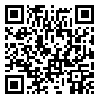Volume 10, Issue 1 (Autumn 2024)
Health in Emergencies and Disasters Quarterly 2024, 10(1): 49-58 |
Back to browse issues page
Ethics code: IR.RCS.REC.1402.023
Download citation:
BibTeX | RIS | EndNote | Medlars | ProCite | Reference Manager | RefWorks
Send citation to:



BibTeX | RIS | EndNote | Medlars | ProCite | Reference Manager | RefWorks
Send citation to:
Fatahi Ardakani M, Zareipour M, Karimi Kiwi H, Yamani Ardakani B, Bahrevar V, Kazemi S. The Perception of Residents About the Performance of Local TV During the 2022 Flash Flood in Yazd, Iran. Health in Emergencies and Disasters Quarterly 2024; 10 (1) :49-58
URL: http://hdq.uswr.ac.ir/article-1-602-en.html
URL: http://hdq.uswr.ac.ir/article-1-602-en.html
Mojtaba Fatahi Ardakani1 

 , Moradali Zareipour2
, Moradali Zareipour2 

 , Hamid Karimi Kiwi3
, Hamid Karimi Kiwi3 

 , Batool Yamani Ardakani4
, Batool Yamani Ardakani4 

 , Vali Bahrevar5
, Vali Bahrevar5 

 , Sadegh Kazemi *6
, Sadegh Kazemi *6 




 , Moradali Zareipour2
, Moradali Zareipour2 

 , Hamid Karimi Kiwi3
, Hamid Karimi Kiwi3 

 , Batool Yamani Ardakani4
, Batool Yamani Ardakani4 

 , Vali Bahrevar5
, Vali Bahrevar5 

 , Sadegh Kazemi *6
, Sadegh Kazemi *6 


1- Department of Health Education, School of Health, Shahid Sadougi University of Medical Science, Yazd, Iran., Continuous Education, Shahid Sadoughi University of Medical Sciences, Yazd, Iran
2- Department of Public Health, School of Health, Khoy University of Medical Sciences, Khoy, Iran., Department of Public Health, Khoy University of Medical Sciences, Khoy, Iran
3- Applied Science Higher Education Institute, Red Crescent Society of the Islamic Republic of Iran, Tehran, Iran., Applied Science Higher Education Institute Red Crescent Society of the Islamic Republic of Iran, Tehran,Iran
4- Department of Health Education, School of Health, Shahid Sadougi University of Medical Science, Yazd, Iran., Shahid Sadougi University of medical science and health services,Yazd, Iran
5- Department of Health Education, School of Health, Shahid Sadougi University of Medical Science, Yazd, Iran., Department of Aging,University of social welfare and rehabilitation sciences, Teharn, Iran -Shahid Sadoughi University of medical sciences and health services,Yazd,Iran
6- Research Center for Emergency and Disaster Resilience, Red Crescent Society of the Islamic Republic of Iran, Fars, Iran. ,info.sadeghkazemi@gmail.com
2- Department of Public Health, School of Health, Khoy University of Medical Sciences, Khoy, Iran., Department of Public Health, Khoy University of Medical Sciences, Khoy, Iran
3- Applied Science Higher Education Institute, Red Crescent Society of the Islamic Republic of Iran, Tehran, Iran., Applied Science Higher Education Institute Red Crescent Society of the Islamic Republic of Iran, Tehran,Iran
4- Department of Health Education, School of Health, Shahid Sadougi University of Medical Science, Yazd, Iran., Shahid Sadougi University of medical science and health services,Yazd, Iran
5- Department of Health Education, School of Health, Shahid Sadougi University of Medical Science, Yazd, Iran., Department of Aging,University of social welfare and rehabilitation sciences, Teharn, Iran -Shahid Sadoughi University of medical sciences and health services,Yazd,Iran
6- Research Center for Emergency and Disaster Resilience, Red Crescent Society of the Islamic Republic of Iran, Fars, Iran. ,
Abstract: (2331 Views)
Background: Flash floods can cause significant damage if people perceive them as low risk. Media plays a crucial role in improving risk perception. This study aims to survey the perceptions of residents in Yazd, Iran, about the performance of local TV during the flash flood in 2022.
Materials and Methods: This is a qualitative study using a content analysis method that was conducted on 22 residents (14 males and 8 females) who had a history of watching local TV programs during the 2022 flash flood in Yazd City. They were selected by purposive sampling method until data saturation. The data was collected through a semi-structured face-to-face interview using open-ended questions about the news received from local TV regarding the flash flood in the city. Qualitative data analysis was done using Colaizzi’s seven-step method.
Results: Data analysis led to the emergence of one main concept (information quality), five themes (time of broadcasting news, content of programs, trust in the media, and ability to increase social sensitivity), 12 sub-themes, and 48 codes.
Conclusion: The effectiveness of local TV during the flash flood in Yazd is low due to incorrect weather predictions, insufficient risk emphasis, lack of prime-time broadcasts, generic messaging, and absence of news headlines. Addressing these issues can enhance people’s perceived sensitivity and response to flood warnings from the local TV.
Materials and Methods: This is a qualitative study using a content analysis method that was conducted on 22 residents (14 males and 8 females) who had a history of watching local TV programs during the 2022 flash flood in Yazd City. They were selected by purposive sampling method until data saturation. The data was collected through a semi-structured face-to-face interview using open-ended questions about the news received from local TV regarding the flash flood in the city. Qualitative data analysis was done using Colaizzi’s seven-step method.
Results: Data analysis led to the emergence of one main concept (information quality), five themes (time of broadcasting news, content of programs, trust in the media, and ability to increase social sensitivity), 12 sub-themes, and 48 codes.
Conclusion: The effectiveness of local TV during the flash flood in Yazd is low due to incorrect weather predictions, insufficient risk emphasis, lack of prime-time broadcasts, generic messaging, and absence of news headlines. Addressing these issues can enhance people’s perceived sensitivity and response to flood warnings from the local TV.
Type of article: Research |
Subject:
Qualitative
Received: 2024/01/24 | Accepted: 2024/07/7 | Published: 2024/10/1
Received: 2024/01/24 | Accepted: 2024/07/7 | Published: 2024/10/1
Send email to the article author
| Rights and permissions | |
 |
This work is licensed under a Creative Commons Attribution-NonCommercial 4.0 International License. |





